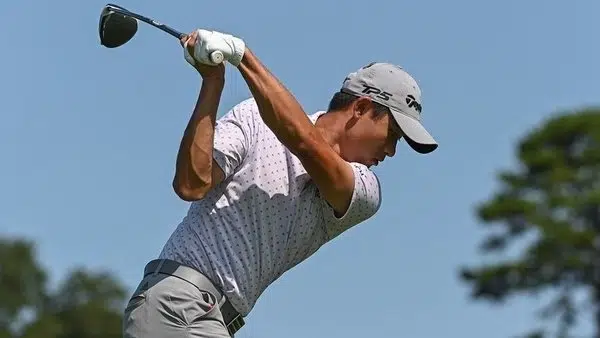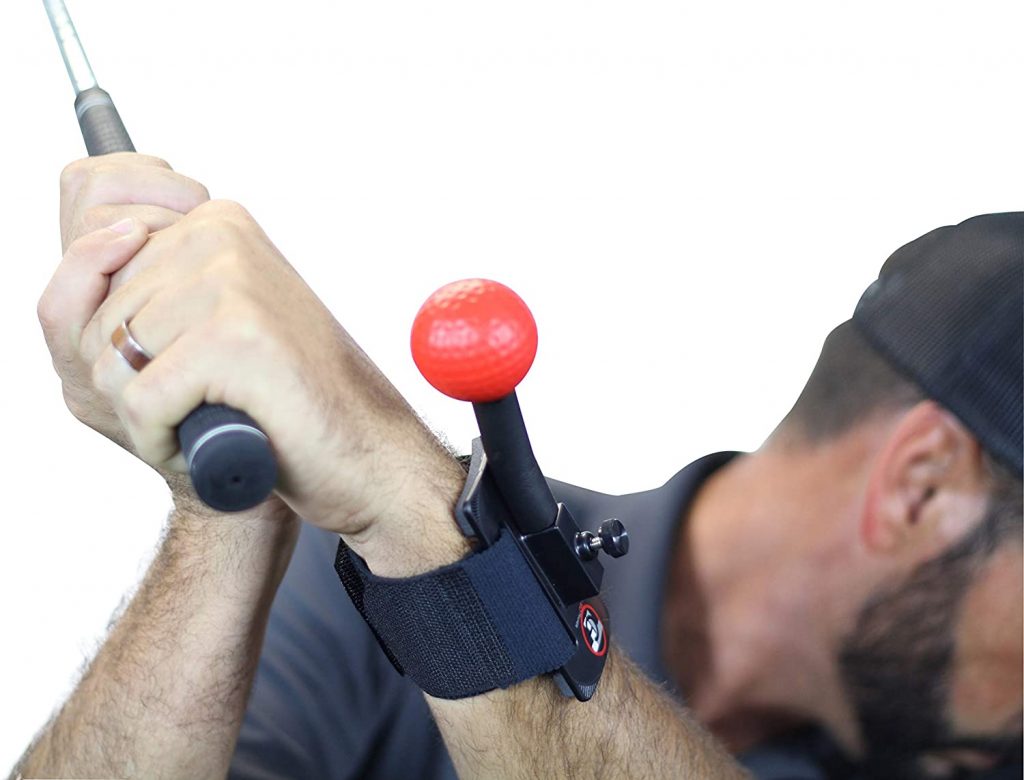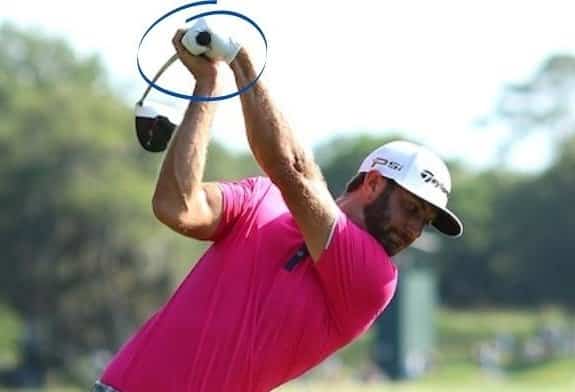There has been increased interest in the benefits of using an overly flexed, or ‘bowed’, left wrist in the golf swing in recent years due to the vast successes of American players Dustin Johnson and Brooks Koepka.
Both players have been tournament-winning machines who bomb the ball a mile, with the unique feature of their swings without doubt being the very bowed wrists they have at the top of their backswing and at impact.
We’ve even seen rising stars such as Collin Morikawa play with a bowed left wrist – and given he already has multiple major championship wins to his name at such a young age, it begs the question: should we all be playing with bowed left wrists?
A bowed left wrist in the golf swing (for right-handed players) can help hold the clubface more stable through impact, however it requires a far greater hip turn in order for the clubface to return square to the ball. If you don’t open your hips enough, you’re more likely to hook the ball with a bowed left wrist.
The reason for this is that flexing, or bowing, the left wrist puts the clubface in a closed position.
It’s no surprise then that the three players mentioned about – Johnson, Koepka and Morikawa – all generate a huge clearing of the hips as they move through the impact zone, which helps counteract their closed clubface and ensures it arrives at the ball square.
So, is the bowed left wrist something you should be trying to emulate in your own golf swing?
Keep reading, as in this article I’ll explain the pros and cons of a flexed left wrist and reveal whether or not you should be incorporating it into your game.
Table of contents
What is a bowed left wrist in golf?
A bowed left wrist in golf describes the motion of your wrist entering a position of ‘flexion’. The opposite of this would be a cupped left wrist, which describes your wrist entering a position of ‘extension’. Bowing the left wrist can help hold the clubface more stable throughout the swing and prevent a flipping of the hands at impact, leading to better compression of the golf ball.
Obviously, the middle ground between a bowed and cupped left wrist can be described as a ‘neutral’ position.
Some players will naturally have a greater degree of flexion in their left wrist based on natural flexibility – for example, Johnson’s bowing of his wrist is extreme, while Morikawa’s is somewhat more subtle.
But if your wrist is flexed even a few degrees past neutral, it can be considered ‘bowed’

What does a bowed left wrist do in the golf swing?
A bowed left wrist closes the clubface during the golf swing, but also promotes greater shaft lean. While bowing your left wrist can hold the clubface more stable and generate better compression, it can also cause hooks and pulls if you don’t adequately clear your hips at impact.
Many modern-day golf instructors are advocates of a bowed left wrist for amateurs (and pros alike) as it can help eradicate some common swing flaws – such as flipping of the hands at impact, fat and thin strikes and early extension – which can hinder your consistency.
The theory is that by placing the left wrist into a bowed position as early as possible in the backswing, all you then have to do is aggressively clear your hips out the way while maintaining that pre-set, flexed wrist angle throughout.
By doing this, you’re relying less on timing with your hands in order to square and then release the clubhead and are instead letting your hips and all the bigger muscles and joints in your body – such as your chest and legs – guide the clubface back onto the ball.
Proponents of a bowed left wrist will argue that eliminating movement in your wrist joints by placing them into an early flexed position will help your swing be more repeatable and, therefore, consistent.
Should you bow your left wrist in the golf swing?
There should always be a degree of flexion in your left wrist as you strike the golf ball. However, not all players will benefit from trying to bow their left wrist at the top of their backswing – namely players with poor wrist or hip flexibility, as it will be difficult for them to square the club at impact.
There is a reason why Dustin Johnson is one of the best golfers in the world – it’s because he has been playing golf since a very young age and has been able to make his extremely bowed left wrist work for him.
His swing is incredibly unique. He generates a massive clearing of his hips, while staying well and truly in his side bend through impact – much more so than many other players on the PGA Tour.
The fact he is 6 feet, 4 inches tall also helps him create unbelievable power off the tee.
The reason I’m pointing all this out is to remind you of one important thing: you are not DJ.
You likely aren’t 193cm tall. You probably don’t have the unique flexibility he has in his left wrist to be able to bow it in such an extreme manner. And you probably aren’t as supple in the hips.
So, should you bow your left wrist in your golf swing? The answer is: it depends on how the rest of your body moves in your swing.
If you’re someone who has stiff hip joints, placing your left wrist in a hugely bowed position is likely going to have you hitting massive hooks all day long, as you probably won’t be able to clear them quickly enough to counteract the shut clubface position that a flexed wrist will create.
Instead, you would probably benefit more from trying to achieve a more neutral wrist position that marries up with how your hips move.
Players like Patrick Reed and Fred Couples have left wrists that are far closer to a ‘cupped’ position, rather than bowed, yet they’ve both been incredibly successful on the world stage.
The old adage of ‘swing your own swing’ could not be truer in this instance, and you shouldn’t be trying to emulate Johnson’s bowed wrist without knowing the knock-on affect it will have on the rest of your swing.
While there are benefits to a bowed left wrist, as I’ve explained above, I wouldn’t go making any massive changes without first seeing a qualified golf instructor who can assess how your body moves throughout your swing and recommend a wrist position that complements those movements.
Is a bowed left wrist good in golf?
A bowed left wrist in golf can help promote a more stable clubface and increased shaft lean, which can be beneficial for players who ‘flip’ their hands at the ball. However, a flexed wrist also causes a closed clubface which – if not synced correctly with a clearing of the hips – can lead to hooks or pulls.
As mentioned before, placing your left wrist into a flexed position is neither right or wrong – what matters is if it suits your swing.
If you’re someone who has a tendency to early extend your body, stand up out of your posture and throw your hands at the ball (if you tend to hit high, weak slices then this probably applies to you), then placing your left wrist into a bowed position earlier in your backswing may be beneficial.
It will train your body to move in a different way – such as clearing the hips better and getting the shaft leaning ahead of the ball at impact – which can lead to straighter, more penetrating shots.
That said, if you’re someone who already finds plenty of fairways playing with a more neutral wrist position, or even a cupped one, then it makes little sense to change it to a bowed position purely because Dustin Johnson does it.
It’s important to first diagnose what your swing flaws are and then decide if applying a bowed left wrist will help alleviate the problem, or make it worse.
If you don’t want to see a golf instructor, then I’d recommend recording your swing at home or on the range (we’ve written a guide on how to do that here) and trying to emulate the movements of some of the world’s best golfers who have a swing as similar to yours as possible.
Sometimes imitating the elite players is the best way to learn and get better.
How to bow your left wrist in the golf swing
To bow your left wrist in the golf swing, when you start your downswing you should feel as though you twist the grip of the club away from you. This will move your left wrist into the bowed position. Try maintaining that angle right the way through impact, focusing on keeping the clubface square and shaft leaned forward in front of the ball at the moment of contact.
Getting your left wrist into a flexed position requires lots of repetition in practice and, above all else, keeping the thought and feeling of bowing your wrist in your mind as you make a swing.
At least, this is what most of the internet golf gurus tell you to do.
But, if you’re someone like me who struggles to differentiate between feel versus real, how are you meant to know if you’re bowing your left wrist correctly or not?
Below, I’ve described two ways that you can get the feedback you need to ensure your wrist is nice and flexed right through your swing.
Option 1: Record your swing
This is easily the best and most efficient way to make big changes in your golf swing.
Simply set up a tripod behind you at the driving range or home practice net – you can buy the UltraPro 72-inch model cheap off Amazon that comes with an attachment for your smartphone – and start hitting three-quarter-shots with a 7-iron while focusing on really bowing your left wrist, and holding that angle throughout every shot.
What you’ll likely find is that while you feel like your wrist is massively bowed, the video footage will actually tell a different story – and that your lead wrist will be closer to flat/neutral, rather than bowed.
Keep practicing in front of the camera and you’ll soon make those swing changes permanent, and they’ll become second nature out on the course.

Option 2: Use a training aid
The most effective way I’ve found to make quick but lasting changes in my swing is by using training aids as, personally, I’m someone who needs physical feedback in order to make the necessary adjustments.
The Total Golf Arm Trainer (pictured above), which you can grab off Amazon without blowing your budget, is an affordable aid that is perfect for teaching you how to bow your left wrist correctly.
Simply attach it to your left wrist and take the club to the top of your backswing – if your hand and wrist comes into contact with the padding, it means you haven’t flexed your wrist enough.
Similarly, at impact, you should also try to avoid contacting the padding with your left wrist as this will indicate it has stayed correctly bowed, and that you’ve created enough shaft lean for optimal compression.
Another way for practicing the perfect impact position, especially with irons, is through using an impact bag, such as the Dr Gary Wiren model (we’ve also listed our top impact bags here if you want to check out some others).
Final message
Bowing your left wrist in the golf swing can have some great benefits when done correctly, however you must realise it is not for everyone.
While there should be a degree of flexion in your left wrist (for a right-handed player) when you strike the ball – creating shaft lean, compression and a stable clubface – you don’t necessarily need Dustin Johnson-level bow at the top of the backswing.
If you’re a slicer of the golf ball, try feeling more bowing of the wrist throughout your swing and this may straighten your ball flight.
However, if you’re someone who already hits draws, coupled with the occasional hook, then adding extra flexion to your left wrist may not be the best thing for your golf swing.


